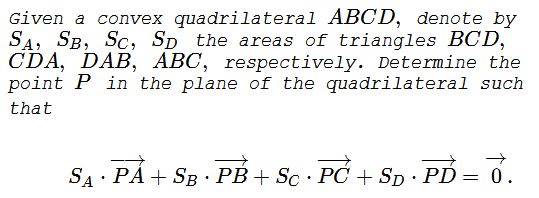A Special Point: Intersection of the Diagonals in Quadrilateral
Problem

Solution 1
Since $D\,$ is outside $\Delta ABC\,$ and inside $\angle ABC,\,$ then for any point $X\,$ from plane we have
$\displaystyle \overrightarrow{XD}=\frac{S_A\cdot\overrightarrow{XA}-S_B\cdot\overrightarrow{XB}+S_C\cdot\overrightarrow{XC}}{S_D}.$
In particular,
$\displaystyle \overrightarrow{PD}=\frac{S_A\cdot\overrightarrow{PA}-S_B\cdot\overrightarrow{PB}+S_C\cdot\overrightarrow{PC}}{S_D},$
implying
$\displaystyle \overrightarrow{0}=S_A\cdot\overrightarrow{PA}+S_B\cdot\overrightarrow{PB}+S_C\cdot\overrightarrow{PC}+S_D\cdot\frac{S_A\cdot\overrightarrow{PA}-S_B\cdot\overrightarrow{PB}+S_C\cdot\overrightarrow{PC}}{S_D},$
from which, $S_A\cdot\overrightarrow{PA}+S_C\cdot\overrightarrow{PC}=\overrightarrow{0}.\,$ Which informs us that the vectors $\overrightarrow{PA}\,$ and $\overrightarrow{PC}\,$ are proportional so that points $A,\,$ $P\,$ and $C\,$ are collinear. Similarly, we obtain that the points $B,\,$ $P\,$ and $D\,$ are also collinear. We conclude that $P\,$ is the intersection of the diagonals $AC\,$ and $BD.$
Solution 2
Let $I\,$ be the intersection of the diagonals. From
$S_A\cdot\overrightarrow{PA}+S_B\cdot\overrightarrow{PB}+S_C\cdot\overrightarrow{PC}+S_D\cdot\overrightarrow{PD}=\overrightarrow{0}$
we get
$\displaystyle\overrightarrow{0}=\sum_{cycl}S_A\overrightarrow{PI}+\sum_{cycl}S_A\cdot\overrightarrow{IA},$
i.e.,
$2[ABCD]\overrightarrow{PI}+ S_A\cdot\overrightarrow{IA}+S_B\cdot\overrightarrow{IB}+S_C\cdot\overrightarrow{IC}+S_D\cdot\overrightarrow{ID}=\overrightarrow{0},$
In $\Delta ABC,\,$ $\displaystyle\frac{IA}{IC}=\frac{[ABI]}{[CBI]};\,$ $\Delta ADC,\,$ $\displaystyle\frac{IA}{IC}=\frac{[ADI]}{[CDI]}.\,$ Hence,
$\displaystyle\frac{IA}{IC}=\frac{[ABI]}{[CBI]}=\frac{[ADI]}{[CDI]}=\frac{[ABI]+[ADI]}{[CBI]+[CDI]}=\frac{S_A}{S_C},$
such that $\displaystyle\frac{\overrightarrow{IA}}{\overrightarrow{IC}}=-\frac{S_A}{S_C},\,$ i.e., $S_A\cdot\overrightarrow{IA}+S_C\cdot\overrightarrow{IC}=\overrightarrow{0}.\,$
Similarly, $S_B\cdot\overrightarrow{IB}+S_D\cdot\overrightarrow{ID}=\overrightarrow{0}\,$ and, therefore,
$S_A\cdot\overrightarrow{IA}+S_B\cdot\overrightarrow{IB}+S_C\cdot\overrightarrow{IC}+S_D\cdot\overrightarrow{ID}=\overrightarrow{0},$
implying $2[ABCD]\overrightarrow{PI}=\overrightarrow{0},\,$ or, $\overrightarrow{PI}=\overrightarrow{0}.\,$ In other words, $P=I.$
Acknowledgment
I am grateful to Leo Giugiuc who brought the above problem to my attention. The problem (by Dorin Andrica) is #U386 in the awesomemath.org set of problems for 2016. Solutions 1 and 2 are by Leo Giugiuc.
|Contact| |front page| |Contents| |Geometry|
Copyright © 1996-2018 Alexander Bogomolny73518355
